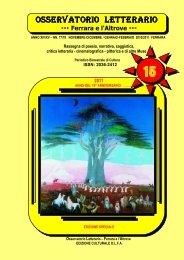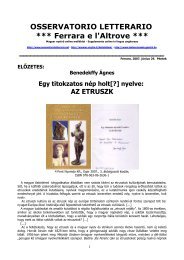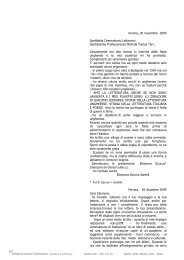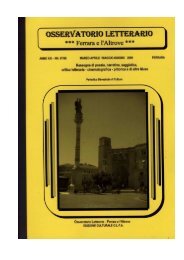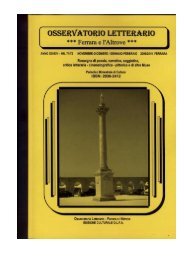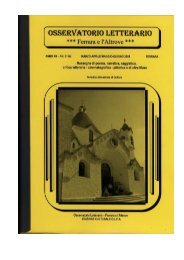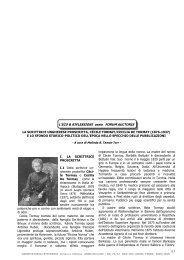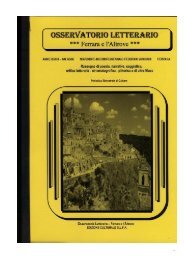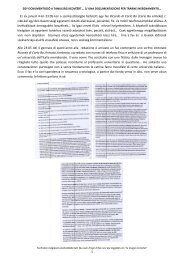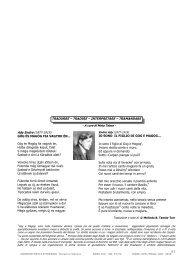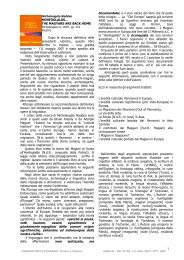http://xoomer.virgilio.it/bellelettere2/curiosita.htm http://xoomer.alice ...
http://xoomer.virgilio.it/bellelettere2/curiosita.htm http://xoomer.alice ...
http://xoomer.virgilio.it/bellelettere2/curiosita.htm http://xoomer.alice ...
Create successful ePaper yourself
Turn your PDF publications into a flip-book with our unique Google optimized e-Paper software.
William Hawking, il fisico br<strong>it</strong>annico - fra i più<br />
importanti e conosciuti del mondo -, l’autore del libro<br />
Dal Big bang ai buchi neri, qualsiasi teoria è provvisoria<br />
e rimane solo un’ipotesi poiché non si può avere la<br />
certezza di provarla in maniera defin<strong>it</strong>iva. Anche se i<br />
risultati di un esperimento sono in accordo con una<br />
teoria, non si può mai essere del tutto sicuri che in un<br />
esperimento successivo i risultati non entrino in<br />
contraddizione con quelli degli esperimenti precedenti.<br />
Del resto per smentire una teoria è sufficiente una sola<br />
osservazione che sia contrasto con le predizioni della<br />
teoria stessa. Quindi riferendo all’opinione del grande<br />
fisico br<strong>it</strong>annico le parole appena sopraddette valgono<br />
per ogni disciplina scientifica cos’anche per la<br />
linguistica, per la storia e naturalmente anche per le<br />
ricerche per scoprire che cosa si nasconde dietro il<br />
mistero degli Etruschi.<br />
Link:<br />
L’articoli consultabili nell’internet dell’Osservatorio Letterario<br />
che trattano argomenti riguardanti agli Etruschi:<br />
<strong>http</strong>://<strong>xoomer</strong>.<strong>virgilio</strong>.<strong>it</strong>/<strong>bellelettere2</strong>/curios<strong>it</strong>a.<strong>htm</strong><br />
<strong>http</strong>://<strong>xoomer</strong>.<strong>alice</strong>.<strong>it</strong>/<strong>bellelettere2</strong>/alinei-anteprima.<strong>htm</strong><br />
<strong>http</strong>://<strong>xoomer</strong>.<strong>alice</strong>.<strong>it</strong>/<strong>bellelettere2</strong>/alineieco.pdf<br />
<strong>http</strong>://<strong>xoomer</strong>.<strong>virgilio</strong>.<strong>it</strong>/<strong>bellelettere2</strong>/szinia.pdf<br />
<strong>http</strong>://www.osservatorioletterario.net/enigmaetrusco51-<br />
52.pdf<br />
<strong>http</strong>://www.osservatorioletterario.net/enigmaetrusco3.pdf<br />
<strong>http</strong>://osservatorioletterario.net/enigmaetrusco4_osservatorio<br />
59-60.pdf<br />
Fonte: Supplemento online dell’«Osservatorio Letterario» di<br />
Ferrara, del 20 novembre 2008:<br />
<strong>http</strong>://www.osservatorioletterario.net/oggettomisterioso.pdf<br />
DALL’ALTROVE…<br />
Melinda B. Tamás-Tarr<br />
- Ferrara -<br />
A Hungarian victim of the Soviet massacre of<br />
Polish POW officers at Katyń, Charkow and Twer<br />
in 1940<br />
It is known only by a comparatively few people that<br />
among the victims of the 1940 massacre of Polish POW<br />
officers by Russian NKVD un<strong>it</strong>s under the command of<br />
the “Soviet Eichmann”, colonel Petr Karpovich<br />
Soprunienko, there was also a Hungarian, Emanuel<br />
Aladár Korompay, lecturer of Hungarian language of<br />
Warsaw Józef Piłsudski Univers<strong>it</strong>y.<br />
The German-Russian (or Ribbentrop-Molotov) Non-<br />
Aggression Pact, signed on the 23 rd Aug. 1939 in<br />
Moscow had a secret annex, dividing Poland between<br />
Germany and the USSR and declaring that the Baltic<br />
states and Finland belong to the Soviet sphere of<br />
influence. Germany attacked Poland on the 1 st<br />
September 1939, occupying the western half of the<br />
country. This was followed by the Russian attack –<br />
w<strong>it</strong>hout declaring war – on the 17 th . They occupied the<br />
eastern half of the country and deported 1.2 million<br />
Poles into the internal parts of the USSR. (Half of them<br />
have survived <strong>it</strong>.). A great number of Poles fled to<br />
Hungary and Romania.<br />
The Polish mil<strong>it</strong>ary officers, who became POW’s of<br />
the Soviet army and were found to be unreliable for the<br />
USSR in the following investigations lasting for months,<br />
were secretly sentenced to death. This was done on the<br />
recommendation of Lavrentii Beriia, people’s commissar<br />
(minister) of the interior, on the 5 th March 1940 by the<br />
Pol<strong>it</strong>ical Comm<strong>it</strong>tee of the Central Comm<strong>it</strong>tee of the<br />
Soviet Communist Party, w<strong>it</strong>h the agreement of<br />
I.V.Stalin, who signed the corresponding document,<br />
that was kept secret and was denied even to exist for<br />
50 years.<br />
Emanuel Aladár Korompay – in the earlier<br />
documents his name is given as Manó Aladár Korompay<br />
– was born in Budapest on the 23 rd March 1890. He<br />
was the seventh child of his parents, he was Roman<br />
Catholic. His father, Márton Korompay was a<br />
pharmacist. He attended the Reformed (Calvinist)<br />
secondary school at Street Lónyay in Budapest, as<br />
w<strong>it</strong>nessed by the yearbooks of the school. His<br />
matriculation document No. 614 was issued there on<br />
the 24 th June 1908. Following this, from 1908 on to the<br />
second term of the 1911-1912 academic year he was a<br />
student of the Faculty of Arts of Budapest Univers<strong>it</strong>y.<br />
His graduation document (absolutorium) was issued on<br />
the 3 rd October 1912, signed by János Kiss, rector of<br />
the univers<strong>it</strong>y and Ernő Fináczy, Dean of the Faculty of<br />
Arts.<br />
He was first a teacher of Latin and Greek of the<br />
secondary school in Léva in Northern Hungary (now in<br />
Slovakia), but soon after the outbreak of World War I<br />
he was called to the army. He was commandeered to<br />
Przemyśl (then in Austria-Hungary). In 1916 he became<br />
acquainted there w<strong>it</strong>h a Polish lady, Miss Mieczysława<br />
Grabas, acting as an interpreter. First they talked in<br />
German w<strong>it</strong>h each other. They were soon married and<br />
in the same year their first daughter, Ilona was born.<br />
Korompay then payed a short vis<strong>it</strong> to Budapest but<br />
soon returned to Przemyśl. In 1919 he became Polish<br />
c<strong>it</strong>izen and joined to Polish Army as a lieutenant. In<br />
1929 he retired from active service as a captain.<br />
In 1930 he met professor Adorján Divéky (1880-<br />
1956), teaching then both at the Báthory Univers<strong>it</strong>y in<br />
Wilno (then in Poland, now Vilnius in L<strong>it</strong>huania) and at<br />
the Józef Piłsudski Univers<strong>it</strong>y in Warsaw. He has taken<br />
over the teaching of Hungarian in Warsaw, the tasks of<br />
the cultural attaché at the Hungarian Embassy in the<br />
Polish cap<strong>it</strong>al and also the chairmanship of the Polish-<br />
Hungarian Association from Divéky. His family has<br />
moved to Warsaw. Soon two girls were born there in<br />
the family, Marta and Elisabeth. It was recorded, that<br />
he was a good player of piano, flute and organ. – He<br />
published a small Hungarian-Polish Dictionary on the<br />
15 th March (the Hungarian national holiday) of 1936,<br />
soon followed by <strong>it</strong>s Polish-Hungarian counterpart. He is<br />
the author of a Polish-Hungarian book of conversations<br />
too.<br />
In 1939, together w<strong>it</strong>h a group of Poles learning<br />
Hungarian, he came to vis<strong>it</strong> Budapest. During their stay<br />
there, World War II broke out. The members of the<br />
group have survived <strong>it</strong> in Hungary, he, however,<br />
immediately returned to Warsaw and obeyed the call to<br />
OSSERVATORIO LETTERARIO Ferrara e l’Altrove ANNO XIII – NN. 67/68 MARZO-APRILE/MAGGIO-GIUGNO 2009 109
join the army. As a member of the staff of the<br />
Hungarian Embassy, he could have obtained an<br />
exemption, but he did not use this opportun<strong>it</strong>y. In the<br />
same year he was taken prisoner of war of the Soviet<br />
Army. He was taken to the Starobielsk camp, one of the<br />
three camps for officers. (The other two camps were in<br />
Kozielsk and in Twer.) Removing his insignia of rank he<br />
could have left the camp, but he refrained from doing<br />
<strong>it</strong>. – A postcard sent from the camp to his wife in<br />
Warsaw has survived until now.<br />
In April and May 1940, 3739 POW’s of the<br />
Starobielsk camp were shot dead in the nearby<br />
Kharkov, in the cellar of the Soviet Secret Police, the<br />
NKVD, and were then buried in Piatihatki. A monument<br />
honouring those killed was consacrated there on the<br />
17 th June 2000. The list of the names of the POW’s<br />
killed in Kharkov is included in the book ent<strong>it</strong>led<br />
“Rozstrzelani w Charkowie” (Shot Dead in Kharkov),<br />
published in Warsaw by the Ośrodek Karta Publisher in<br />
1996. The name of Emanuel Aladár Korompay is the<br />
second in column 3, on page 94.<br />
The first memorial tablet honouring Emanuel<br />
Korompay was unveiled on the wall of his former home<br />
in Warsaw, at the corner of streets Podchorążych and<br />
Holówki on the 12 th April 1992. At Warsaw Univers<strong>it</strong>y<br />
on the building of Oriental Studies – housing once the<br />
Hungarian Department – at 26/28 Krakowskie<br />
Przedmiescie, on Hungarian in<strong>it</strong>iative, on the 21 st<br />
November 2002 a Korompay memorial was unveiled,<br />
w<strong>it</strong>h mil<strong>it</strong>ary honours, in the presence of a delegation of<br />
the Hungarian Parliament headed by the historian,<br />
Tamás Katona MP. This was the first act of the<br />
celebrations marking the 50 th anniversary of the<br />
Hungarian Department. The inscription of the memorial<br />
reads:<br />
Emanuel Korompay / 1890-1940 / lektor języka<br />
węgierskiego / na Uniwers<strong>it</strong>ecie Warszawskim w latach<br />
1930-1939, / kap<strong>it</strong>an Wojska Polskiego, / uczestnik<br />
kampanii wrześniowej 1939, / więzień obozu w<br />
Starobielsku, zamordowany w Charkowie / –<br />
In English translation: Emanuel Korompay / 1890-<br />
1940 / Lecturer of Hungarian language / at the<br />
Univers<strong>it</strong>y of Warsaw between 1930 and 1939 / captain<br />
of the Polish Army, / participant of the 1939 September<br />
campaigne / prisoner of the Starobielsk camp, killed in<br />
Kharkov.<br />
Hopefully sooner or later his birthplace, Budapest<br />
will also give him a due comme-moration.<br />
Gyula Paczolay<br />
– Veszprém (H) –<br />
Note. 4441 detainees of the Kozielsk camp were<br />
killed in Katyń, and were also buried there, the list of<br />
their names was published in 1995. The list of names of<br />
6311 POW’s of the Ostaszków camp, most of them<br />
reserve officers and Polish intellectuals, murdered in<br />
Twer and buried in Miednoje, was published in 1997. –<br />
According to official Soviet data 7305 more detainees<br />
were killed in different prisons. – 448 selected<br />
prisoners of the three camps, considered reliable, were<br />
taken to the Griazowiec camp, they have survived, their<br />
correspondence w<strong>it</strong>h their families has continued after<br />
April 1940.<br />
In July 1946 in the Nuremberg International Court of<br />
Justice the Russian prosecutor Pokrovskii charged the<br />
Germans w<strong>it</strong>h killing the Polish officers. The court has<br />
dropped the charge. In sp<strong>it</strong>e of this, for fifty years the<br />
Russians blamed the Germans for killing the Polish<br />
officers and <strong>it</strong> was the official policy of the satell<strong>it</strong>e<br />
countries too. The booklet of the Polish journalist<br />
Bolesław Wójcicki, ent<strong>it</strong>led “The truth about Katyń”<br />
blaming the Germans for the crime was published<br />
twice, in 1952 and 1953. – A memorial bearing the<br />
inscription: 1940 Katyń – Starobielsk – Ostaszków was<br />
set up on the 31 st July 1981 at Warsaw Powońzki<br />
Mil<strong>it</strong>ary Cemetary. It was destroyed on the following<br />
night by the Polish Secur<strong>it</strong>y Services.<br />
It was on the 13 th April 1990 that President Mikhail<br />
Gorbachev confessed to the crime and then some of<br />
the corresponding documents were handed over to the<br />
Polish President Lech Walęsa by President Boris Jeltsin,<br />
who also paid tribute to the victims in the Powońzki<br />
Cemetery in Warsaw. – The monument honouring the<br />
victims of the massacre was consacrated in Katyń on<br />
the 28 th July 2000, in Twer on the 2 nd September 2000.<br />
Gyula Paczolay<br />
Slightly revised version of the article, published in the<br />
Hungarian weekly Élet és Tudomány (Life and Science) Vol.<br />
63. No 19. p 589-590. (9 th May, 2008)<br />
110<br />
OSSERVATORIO LETTERARIO Ferrara e l’Altrove ANNO XIII – NN. 67/68 MARZO-APRILE/MAGGIO-GIUGNO 2009



